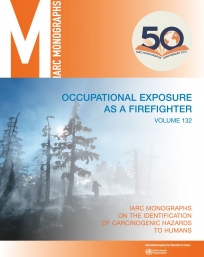
978-92-832-0131-1
978-92-832-0199-1
View The Lancet Oncology summary as HTML or PDF
French version of The Lancet Oncology summary (hosted by Centre Léon Bérard)
Read Q&A
View infographic
This volume of the IARC Monographs provides an evaluation of the carcinogenicity of occupational exposure as a firefighter.
Occupational exposure as a firefighter is complex and includes a variety of hazards resulting from fires and non-fire events. Firefighters can have diverse roles, responsibilities, and employment (e.g. full-time, part-time, volunteer) that vary widely across countries and change over their careers. Firefighters respond to various types of fire (e.g. structure, wildland, and vehicle fires) and other events (e.g. vehicle accidents, medical incidents, hazardous material releases, and building collapses). Wildland fires are increasingly encroaching on urban areas. Changes in types of fire, building materials, and personal protective equipment have resulted in significant changes in firefighter exposures over time.
Firefighters may be exposed to combustion products from fires (e.g. polycyclic aromatic hydrocarbons, particulate matter), building materials (e.g. asbestos), chemicals in firefighting foams (e.g. per- and polyfluorinated substances), flame retardants, diesel exhaust, as well as other hazards (e.g. night shift work and ultraviolet or other radiation).
An IARC Monographs Working Group reviewed evidence from cancer studies and mechanistic studies in humans to assess the carcinogenic hazard to humans of occupational exposure as a firefighter and concluded that:
Occupational exposure as a firefighter is carcinogenic to humans (Group 1).
Annex 1. Supplementary material for Section 1, Exposure Characterization
Please report any errors to imo@iarc.who.int.
Table S1.2 Number of firefighters, by employment status, in 57 countries
Table S1.11 Biomonitoring methods for chemical and physical agents excluding fire smoke components
Table S1.25 Biomarkers of exposure other than fire smoke and polycyclic aromatic hydrocarbons
The following tables were produced in draft form by the Working Group and were subsequently fact-checked but not edited:
Annex 2. Supplementary material for Section 2, Cancer in Humans
Please report any errors to imo@iarc.who.int.